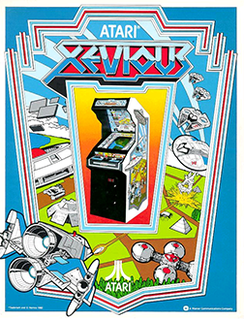 W
WDig Dug is a 1982 maze arcade game developed and published by Namco. It was distributed by Atari, Inc. in North America and Europe. Controlling the titular character, the player is tasked with defeating all of the enemies in each stage, done by either inflating them with air with a pump until they pop or crushing them underneath large rocks. It ran on the Namco Galaga arcade board.
 W
WDig Dug II is a 1985 action puzzle arcade game developed and published in Japan by Namco. It is a sequel to Dig Dug.
 W
WDragon Buster is a platform, dungeon crawling action role-playing game that was developed by Namco and released in 1985. It runs on Namco Pac-Land hardware, modified to support vertical scrolling. In Japan, the game was ported to the Family Computer, MSX and Sharp X68000; the latter version was later released for the Virtual Console in the same region on November 18, 2008. Dragon Buster has been ported for the PSP and is available as part of Namco Museum Battle Collection. It was followed by a Japan-only Famicom sequel, Dragon Buster II: Yami no Fūin, and was later followed by the PlayStation game Dragon Valor, which was both a remake and sequel.
 W
WPac & Pal is a 1983 maze chase arcade game developed and published by Namco. It is part of the company's Pac-Man series, is the third to have been produced in-house. Players control Pac-Man as he must eat the items in an enclosed maze while avoiding four colored ghosts that pursue him. Pac-Man is assisted by a green-colored creature named Miru, the titular "Pal", who brings the items back to the center box. Pac-Man can also collect power-ups that allow him to briefly stun the ghosts.
 W
WPac-Land is a 1984 side-scrolling platform arcade game developed and published by Namco. In North America, it was distributed by Midway Games. Controlling Pac-Man, the player must make it to the end of each stage to return a lost fairy back to its home in Fairyland. Pac-Man will need to avoid obstacles, such as falling logs and water-spewing fire hydrants, alongside his enemies the Ghost Gang. Eating large flashing Power Pellets will cause the ghosts to turn blue, allowing Pac-Man to eat them for points. It was the first game to run on the Namco Pac-Land hardware.
 W
WPac-Mania is an isometric maze arcade game that was developed and released by Namco in 1987. In the game, the player controls Pac-Man as he must eat all of the dots while avoiding the colored ghosts that chase him in the maze. Eating large flashing "Power Pellets" will allow Pac-Man to eat the ghosts for bonus points, which lasts for a short period of time. A new feature to this game allows Pac-Man to jump over the ghosts to evade capture. It is the ninth title in the Pac-Man video game series and was the last one developed for arcades up until the release of Pac-Man Arrangement in 1996. Development was directed by Pac-Man creator Toru Iwatani. It was licensed to Atari Games for release in North America.
 W
WPole Position is an arcade racing video game that was released by Namco in 1982 and licensed to Atari, Inc. for US manufacture and distribution, running on the Namco Pole Position arcade system board. It was the most popular coin-operated arcade game of 1983, and is considered one of the most important titles from the video arcade's golden age. Pole Position was released in two configurations: a standard upright cabinet, and an environmental/cockpit cabinet. Both versions feature a steering wheel and a gear shifter for low and high gears, but the environmental/cockpit cabinet featured both an accelerator and a brake pedal, while the standard upright one only featured an accelerator pedal.
 W
WSuper Xevious is a 1984 vertical-scrolling shooter arcade game developed and published by Namco in Japan. It is an updated version of Xevious (1983), created as a response to the overwhelming success of the original in Japan. Like the original game, the player controls a starship known as the "Solvalou", equipped with two weapons: an "air zapper" to defeat flying enemies, and a "blaster bomb" to destroy ground-based enemies. It runs on the Namco Galaga arcade board. New enemy types include metallic Galaxian flagships. Some of these revert the player's score to zero if destroyed. It has been ported to the Sharp X68000 and PlayStation, alongside inclusion in several Namco collections.
 W
WXevious is a 1983 vertical-scrolling shooter arcade game developed and published by Namco. In North America, it was published by Atari, Inc.. Controlling the Solvalou starship, the player is tasked with wiping out the Xevious forces before they destroy all of mankind. The Solvalou has two weapons at its disposal: an air zapper to destroy flying enemies, and a blaster bomb to destroy ground-stationed enemies. It ran on the Namco Galaga arcade system.